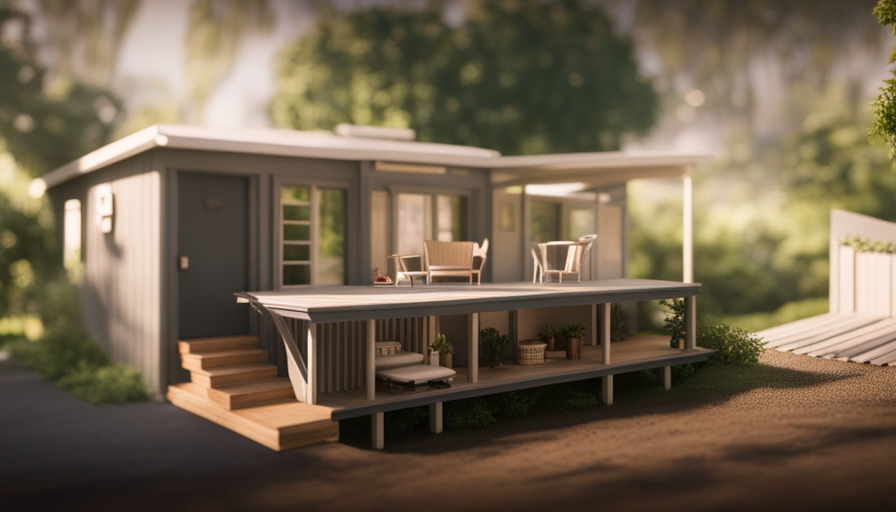Have you ever thought about the heaviness of a 40 ft tiny house? Understanding the weight of a tiny house is crucial for its design, construction, and safe, efficient transportation.
In this article, I will delve into the basics of tiny house construction and explain why weight considerations are essential. We will explore the factors that contribute to the weight of a 40 ft tiny house and learn how to calculate its weight accurately. Additionally, I will provide you with the average weight range for a 40 ft tiny house and discuss the considerations for towing or transporting it. If you’re looking to reduce the weight of your 40 ft tiny house, I’ve got some tips for you as well.
Lastly, we will explore the potential challenges and benefits of a well-balanced and properly weighted 40 ft tiny house. So, let’s dive in and unravel the mysteries of how much a 40 ft tiny house really weighs!
Key Takeaways
- The weight of a 40 ft tiny house is essential for its design, construction, and transportation.
- The average weight of a tiny house ranges from 4,500 to 10,000 pounds, depending on various factors.
- The materials used in construction, insulation, and interior features all contribute to the overall weight of the house.
- Proper weight distribution and staying within the towing capacity of the vehicle are important for safe and efficient transportation of the tiny house.
Understanding the Basics of Tiny House Construction
So, you’re interested in understanding the basics of tiny house construction, huh? Well, let me tell you, one of the first things you need to know is just how much these incredible dwellings weigh.
When it comes to tiny house construction techniques, weight is a crucial factor to consider. The average weight of a tiny house can vary depending on its size, materials used, and design choices. However, most tiny houses weigh between 4,500 to 10,000 pounds.
Sustainability in tiny house design is another important aspect to consider when determining the weight of a tiny house. Many people choose to build tiny houses using eco-friendly and sustainable materials such as reclaimed wood, recycled metal, and energy-efficient insulation. These materials not only reduce the environmental impact but also contribute to the overall weight of the house.
Understanding the weight of a tiny house is essential because it affects various aspects of the construction and design process. It influences the choice of foundation, transportation options, and even the structural integrity of the house. Additionally, weight considerations play a significant role in ensuring that the tiny house meets safety regulations and can be legally transported on public roads.
Knowing the weight of a tiny house is just the first step in understanding the importance of weight considerations in tiny house design. These considerations go beyond just the physical weight and extend to the overall balance, stability, and functionality of the dwelling.
The Importance of Weight Considerations in Tiny House Design
Considering weight is crucial in designing a tiny home, as it impacts every aspect of its functionality, from mobility to sustainability. When it comes to weight considerations in tiny house design, one of the key factors to take into account is weight distribution. Proper weight distribution ensures that the tiny house is balanced and stable, especially during transportation. This involves strategically placing heavier components, such as furniture and appliances, closer to the center of the house to prevent any imbalance that could affect towing capacity.
Towing capacity is another important aspect to consider when designing a tiny house. It refers to the maximum weight that a vehicle can safely tow. It is crucial to stay within the towing capacity of the vehicle that will be used to transport the tiny house. Exceeding the towing capacity can lead to safety hazards, such as poor vehicle performance and increased risk of accidents.
Now, let’s delve into the factors that contribute to the weight of a 40 ft tiny house, including materials used, insulation, and interior features.
Factors that Contribute to the Weight of a 40 ft Tiny House
To understand the weight of a 40 ft tiny house, you need to consider factors such as the materials used, insulation, and interior features. These factors greatly influence the overall weight of the structure and should be carefully considered during the design process. Here are four key factors that affect the weight of a 40 ft tiny house:
-
Building materials: The type of materials used, such as wood, steel, or concrete, can significantly impact the weight of the tiny house. For instance, a tiny house built with heavy materials like concrete will be much heavier than one constructed with lightweight materials like wood.
-
Insulation: The amount and type of insulation used in the walls, roof, and floor of the tiny house can add significant weight. While insulation is essential for maintaining a comfortable interior temperature, it’s important to strike a balance between insulation and weight.
-
Interior features: The inclusion of appliances, furniture, and other interior features can add considerable weight to the tiny house. It’s crucial to carefully consider the necessity and weight of each item to avoid excessive weight.
-
Weight distribution considerations: Proper weight distribution is essential for a stable and safe tiny house. Factors such as the placement of heavy items, distribution of load-bearing walls, and the location of water tanks and utilities should be carefully planned to ensure a well-balanced structure.
Understanding these factors will help you determine the weight of a 40 ft tiny house. Now, let’s explore how to calculate the weight of a 40 ft tiny house.
How to Calculate the Weight of a 40 ft Tiny House
Let’s delve into the process of calculating the weight of a 40 ft tiny house and discover the secrets behind this crucial measurement.
Calculating the weight of a 40 ft tiny house involves several factors that contribute to its overall mass. One important aspect is determining the weight distribution, which ensures that the house remains stable and safe during transport and use.
To calculate the weight, we need to consider the materials used in the construction, such as the framing, insulation, and finishes. Each material has a specific weight that can be obtained from manufacturer specifications or industry standards. By multiplying the weight per square foot of each material by its corresponding area in the house, we can estimate its contribution to the overall weight.
Additionally, we must take into account the weight of appliances, furniture, and personal belongings that will be inside the tiny house. These items can significantly impact the final weight, especially if they’re heavy or numerous.
Once we have gathered all the necessary data, we can add up the weights of the materials, appliances, furniture, and personal belongings to obtain the total weight of the 40 ft tiny house.
With this knowledge, we can now move on to exploring the average weight range for a 40 ft tiny house, which will provide further insight into the weight considerations for these compact dwellings.
The Average Weight Range for a 40 ft Tiny House
The weight of a 40 ft tiny house can vary greatly, depending on the materials and furnishings used, resulting in a wide range of average weights. When considering the average weight of a 40 ft tiny house, it’s important to take into account the weight distribution throughout the structure. Here are three key factors that contribute to the overall weight of a 40 ft tiny house:
-
Construction Materials: The type and quality of materials used in the construction of the tiny house can significantly impact its weight. For example, a tiny house constructed with lightweight materials such as aluminum or fiberglass will generally weigh less than one built with heavier materials like wood or steel.
-
Furnishings and Appliances: The weight of the furnishings and appliances inside the tiny house can also add to its overall weight. Items such as furniture, kitchen appliances, and bathroom fixtures can contribute significantly to the total weight, especially if they’re made of heavy materials.
-
Water and Electrical Systems: The inclusion of water and electrical systems in a tiny house will also affect its weight. Tanks, pipes, and electrical wiring can add considerable weight, so it’s essential to consider these factors when calculating the average weight.
Considering these factors, it’s crucial to take into account the weight of a 40 ft tiny house when planning for towing or transporting. The weight distribution should be carefully assessed to ensure safe and efficient transportation.
Considerations for Towing or Transporting a 40 ft Tiny House
When it comes to towing or transporting a 40 ft tiny house, there are several important considerations to keep in mind.
First and foremost, choosing the right towing vehicle is crucial to ensure safety and efficiency on the road.
Additionally, ensuring proper weight distribution and balance is essential for a smooth and stable towing experience.
Lastly, obtaining the necessary permits and licenses is vital to stay compliant with local regulations and avoid any legal issues during transportation.
Choosing the Right Towing Vehicle
Finding the right towing vehicle for your ft tiny house is crucial and can greatly impact the overall towing experience. When choosing the right hitch, it’s important to consider the weight and size of your tiny house, as well as the towing capacity of the vehicle.
The hitch should be able to handle the weight of the tiny house and provide a secure connection. Understanding the towing capacity of the vehicle is essential to ensure that it can safely tow the weight of the tiny house. It’s important to check the manufacturer’s specifications and consult with professionals if needed.
Ensuring proper weight distribution and balance is essential for a smooth and safe towing experience. This includes evenly distributing the weight and securing any loose items inside the tiny house.
By taking these factors into consideration, you can choose the right towing vehicle and ensure a safe journey for your ft tiny house.
Ensuring Proper Weight Distribution and Balance
Ensuring proper weight distribution and balance is crucial for a smooth and safe towing experience with your ft tiny house. To achieve this, consider the following balancing techniques:
-
Distribute weight evenly: Place heavier items closer to the trailer’s axles to prevent swaying and maintain stability.
-
Use a weight distribution hitch: This device helps distribute the weight evenly between the towing vehicle and the trailer, improving control and reducing strain on the vehicle.
-
Check the tongue weight: Ensure that the tongue weight is within the recommended range, typically around 10-15% of the total trailer weight, to maintain proper balance.
By implementing these proper weight distribution and balancing techniques, you can enhance the towing experience and minimize the risk of accidents.
Transitioning into the subsequent section about obtaining the necessary permits and licenses, it’s important to understand the legal requirements involved in towing a ft tiny house.
Obtaining the Necessary Permits and Licenses
To ensure a legal and hassle-free towing experience, it’s essential for you to obtain the necessary permits and licenses for your ft tiny house.
When it comes to obtaining permits, it’s important to familiarize yourself with the specific legal requirements in your area. This may include obtaining a building permit or a special permit for towing oversized loads. Additionally, you may need to obtain a license to operate a vehicle with a larger towing capacity.
It’s crucial to comply with these regulations to avoid any legal issues or fines.
Now that we’ve covered the necessary permits and licenses, let’s move on to some tips for reducing the weight of a 40 ft tiny house.
Tips for Reducing the Weight of a 40 ft Tiny House
If you want to shed some pounds off your 40 ft tiny house, there are a few tricks up your sleeve. Here are three tips for reducing weight and maximizing space in your tiny house:
-
Optimize the materials: When building your tiny house, choose lightweight materials such as aluminum or composite panels for the walls, roof, and flooring. These materials aren’t just durable but also significantly lighter than traditional options like wood or concrete.
-
Streamline the design: Every inch counts in a tiny house, so make sure to optimize the layout. Consider using multi-functional furniture and built-in storage solutions to maximize space without adding extra weight. Also, minimize unnecessary partitions and walls to create an open and airy feel while reducing overall weight.
-
Choose compact appliances: Appliances can be a major source of weight in a tiny house. Opt for compact and energy-efficient appliances that are specifically designed for small spaces. There are plenty of options available, including slim refrigerators, compact stoves, and space-saving washer-dryer combos.
By implementing these strategies, you can significantly reduce the weight of your 40 ft tiny house while still maximizing space. However, keep in mind that there are potential challenges and considerations when dealing with heavy tiny houses, which we’ll explore in the next section.
Transitioning into the subsequent section about potential challenges and considerations for heavy 40 ft tiny houses, it’s important to understand the impact of weight on transportation and foundation requirements.
Potential Challenges and Considerations for Heavy 40 ft Tiny Houses
Navigating the challenges of a heavy 40 ft tiny house can be a complex endeavor, with considerations such as transportation logistics and foundation requirements playing a crucial role.
One of the key factors to address is weight distribution. Distributing the weight evenly throughout the tiny house is essential for maintaining stability during transport. This can be achieved by strategically placing heavier items, such as appliances or furniture, near the center of the house. Additionally, reinforcing the frame and using high-strength materials can help support the weight and prevent any structural issues.
Another important consideration is the towing capacity of the vehicle used to transport the tiny house. It’s vital to ensure that the towing vehicle has the appropriate capacity to handle the weight of the house, including any additional weight from personal belongings. Exceeding the towing capacity can lead to safety hazards and potential damage to both the vehicle and the tiny house.
Navigating these challenges requires careful planning and attention to detail. By addressing weight distribution and ensuring the towing capacity is sufficient, the potential challenges associated with heavy 40 ft tiny houses can be mitigated.
This paves the way for the benefits of a well-balanced and properly weighted 40 ft tiny house, such as enhanced stability, improved maneuverability, and minimized wear and tear on both the house and the towing vehicle.
The Benefits of a Well-Balanced and Properly Weighted 40 ft Tiny House
Achieving a well-balanced and properly weighted 40 ft tiny house can lead to enhanced stability, improved maneuverability, and less wear and tear on both the house and the towing vehicle.
One of the key factors in achieving this is weight distribution. Proper weight distribution ensures that the load is evenly distributed throughout the tiny house, preventing any excessive weight on one side or corner. This helps to maintain balance and stability while towing, reducing the risk of swaying or tipping over.
In addition to stability, a well-balanced tiny house also offers improved maneuverability. By distributing the weight evenly, the tiny house becomes easier to control and maneuver, especially when navigating through tight turns or parking in confined spaces. This enhances the overall towing experience and reduces the chances of accidents or damage to the house or surrounding property.
Another advantage of a properly weighted 40 ft tiny house is the reduced wear and tear on both the house and the towing vehicle. When the weight is evenly distributed, the load is distributed more evenly on the tires and suspension of the towing vehicle. This prevents excessive strain on any particular area, prolonging the lifespan of both the vehicle and the tiny house.
It is important to note that achieving a well-balanced and properly weighted 40 ft tiny house also requires considering the towing capacity of the vehicle. The weight of the tiny house should not exceed the maximum towing capacity specified by the vehicle manufacturer. Adhering to this limit ensures safe towing and prevents any potential damage to the vehicle or the tiny house.
Frequently Asked Questions
How much does a 40 ft tiny house typically weigh?
Typically, a 40 ft tiny house weighs around 10,000 to 12,000 pounds. Factors affecting weight include the materials used, appliances, and furnishings. The pros of a heavy tiny house include stability, durability, and insulation. However, cons include transportation restrictions and higher costs.
What are some factors that can contribute to the weight of a 40 ft tiny house?
Factors that can contribute to the weight of a tiny house include the choice of construction materials, the size and design of the house, the presence of additional features like appliances or furniture, and the amount of insulation used.
Are there any considerations for towing or transporting a 40 ft tiny house?
When considering towing a 40 ft tiny house, there are several important considerations. These include the weight of the house, the capacity of the towing vehicle, proper hitching, and transportation logistics.
What are some tips for reducing the weight of a 40 ft tiny house?
To reduce weight in a 40 ft tiny house, design considerations are crucial. Opt for lightweight materials and prioritize efficiency. It’s important to balance structural integrity while maximizing space and minimizing unnecessary additions.
What potential challenges and considerations should be taken into account for heavy 40 ft tiny houses?
Challenges and considerations for heavy 40 ft tiny houses include structural integrity, transportation restrictions, and foundation requirements. Ensuring proper support, obtaining necessary permits, and planning for weight distribution are essential for a successful build.
Conclusion
In conclusion, the weight of a 40 ft tiny house is a topic that requires careful consideration and planning. While it may seem counterintuitive to focus on the weight of something that’s meant to be small and compact, it’s crucial to ensure that the structure is safe, stable, and easy to transport. By calculating the weight and making necessary adjustments, individuals can enjoy the benefits of a well-balanced and properly weighted 40 ft tiny house.
So remember, when it comes to tiny living, weight matters!
Hi, I’m Emma. I’m the Editor in Chief of Tiny House 43, a blog all about tiny houses. While tree houses are often associated with childhood, they can be the perfect adult retreat. They offer a cozy space to relax and unwind, surrounded by nature. And since they’re typically built on stilts or raised platforms, they offer stunning views that traditional homes simply can’t match. If you’re looking for a unique and romantic getaway, a tree house tiny house might just be the perfect option.










